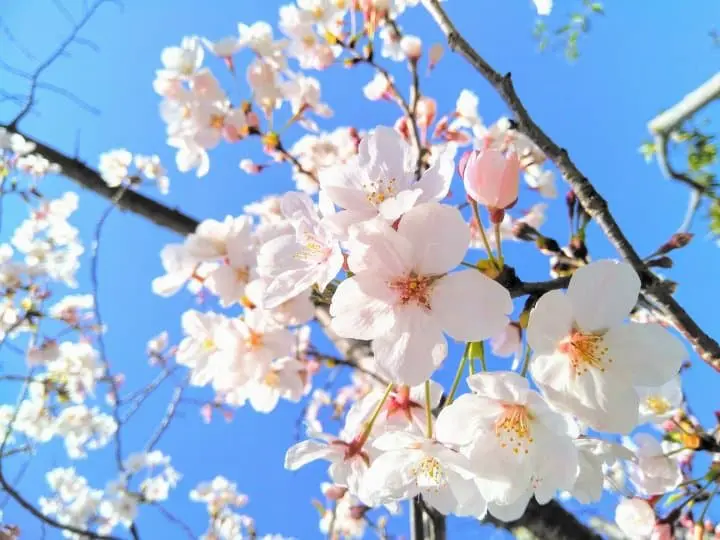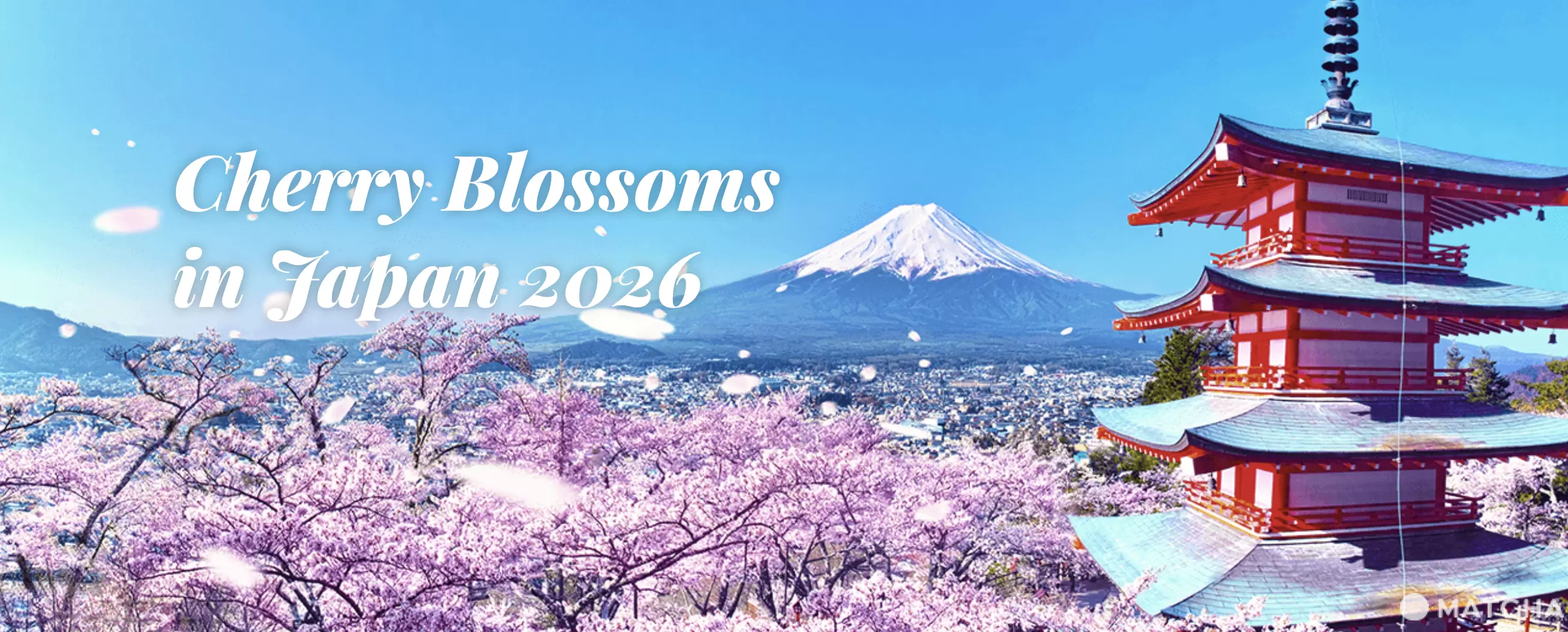Plum, Peach, and Cherry Blossoms: How to Differentiate Them

Plum trees, cherry trees, and peach trees belong to the same plant family, so it's easy to confuse their flowers. Use these hints to distinguish between them and enjoy flower viewing in Japan to the fullest.
Spring Flowers in Japan: Cherry, Plum, and Peach Blossoms
If you had to pick a flower to represent Japan, it would probably be the sakura, or cherry blossoms. Sakura cherry trees bloom everywhere in the spring, with their pink flowers giving Japan’s streets a unique charm.
Plum trees, called ume, and peach trees, called momo, also produce pink flowers in the springtime. Because these trees are all part of the Rosaceae family of plants, even Japanese people have a hard time telling them apart.
Read on to learn how to spot the differences between plum, peach, and cherry blossoms in Japan.
Distinctve Features of Plum, Peach, and Cherry Blossoms
1. Sakura Trees and Cherry Blossoms
2. Plum Trees and Blossoms
3. Peach Trees and Blossoms
Read also
1. Sakura Trees and Cherry Blossoms

When someone mentions Japan, cherry blossoms are one of the first things to spring to mind. They are intrinsic to Japan's national image. In the spring, famous sakura viewing spots across the country are all bustling with activity.
Blooming Time for Cherry Blossoms
From late March to April in eastern and western Japan
Late April in northern Japan, including Hokkaido
Cherry Blossom Characteristics
- Split-tipped petals that form heart shapes
- Long stems and many flowers blooming on one branch, giving off an ostentatious air
Famous Cherry Blossom Locations
Hokkaido: Goryokaku Tower
Tokyo: Sumida Park
Kyoto: Daigoji Temple
Hiroshima: Senkoji Park
Kumamoto: Kumamoto Castle
Some of the sakura varieties can have more petals, lending them even more flamboyance. You will see pale pink flowers the most often.
Read also
2. Plum Blossoms and Trees

Photo by Pixta
Plum trees bloom earlier than sakura, in February, and are thus associated with the end of winter. Plum blossom viewing events are held at Japanese gardens and famous locations such as Fukuoka's Dazaifu Tenmangu Shrine or Kyoto's Kitano Tenmangu Shrine.
Because they start blooming while it is still cold, plum flowers are a pleasant herald of the coming spring.
Blooming Time for Plum Blossoms
From January to around March
Plum Blossom Characteristics
- Round-tipped petals
- No flower stems; the flowers bloom close to the branch
Famous Plum Blossom Locations
Ibaraki: Kairakuen Garden
Tokyo: Imperial Palace East Gardens
Kyoto: Kitano Temmangu Shrine
Fukuoka: Daizaifu Temmangu Shrine
One bud blooms on each spot on a plum tree branch, so they give off a subdued impression compared to sakura or peach trees. They can have white or pale pink flowers, and you may also see deep pink flowers.
3. Peach Blossoms and Trees

Peach blossoms are known as a decoration during the Japanese spring tradition of Girl’s Day (Hina Matsuri), celebrated on March 3.
Historically, this was when peach flowers began to bloom, so the occasion is also known as Momo-no-Sekku, or “peach blossom festival.”
Peach flowers were originally said to work as charms to ward off evil spirits, so they became used as ornamentation during Girl’s Day, a festival to wish for the health and development of children.
Blooming Time for Peach Blossoms
Early to mid-April
Peach Blossom Characteristics
- Petals that taper to sharp points
- The flowers bloom along the very short stems
Two or more flowers bloom from the buds on each side of a peach tree branch, giving them a flashier look than plum trees. There are many vivid pink peach tree flowers.
Famous Peach Blossom Locations
Ibaraki: Koga Park
Yamanashi: Togenkyo, Southern Alps
Nagano: Chikumagawa Beach
These three flowers lend a colorful flair to the Japanese springtime. If you can tell them apart, you'll be able to enjoy the spring scenery even more.
FAQ
Is cherry blossom the same as peach?
Cherry blossoms and peach blossoms, while visually similar in some respects, are distinct flowers with specific characteristics. Cherry blossoms originate from cherry trees in the Prunus genus, with five-petaled flowers that can range in color from white to pink. In contrast, peach blossoms stem from peach trees, specifically Prunus persica, displaying pink petals with a rounder shape. Cherry trees bear cherries as fruits, while peach trees produce peaches, each with unique flavors and textures. Both varieties bloom in spring but may differ slightly in timing, with cherry blossoms renowned for their association with hanami festivals and peach blossoms also symbolizing the arrival of spring in their own right. Despite their differences, cherry blossoms and peach blossoms both hold cultural significance and aesthetic value, enriching art, literature, and traditions worldwide.
What are peach blossoms called in Japanese?
In Japanese, peach blossoms are called "桃の花" (momo no hana). The term "桃" (momo) specifically refers to a peach, and "花" (hana) means flower. Therefore, the term "桃の花" directly translates to "peach flower" or "peach blossom" in Japanese. These blossoms are associated with the arrival of spring and are admired for their delicate beauty and significance in Japanese culture and traditions.
What is the difference between a peach blossom and a plum blossom?
Peach blossoms and plum blossoms are unique flowers with notable differences despite their superficial similarities. Peach blossoms stem from peach trees (Prunus persica) and showcase pink petals, while plum blossoms come from plum trees (Prunus mume) and feature white to light pink flowers. Peach blossoms tend to be larger and more abundant compared to the smaller, delicate plum blossoms. Blooming seasons also vary, with plum blossoms appearing earlier in February to March in Japan, preceding the later blooming peach blossoms in March to April. Additionally, peach trees bear edible peaches, while plum trees produce plums of varying colors and flavors. Symbolically, plum blossoms represent strength and the onset of spring, symbolizing renewal, while peach blossoms are linked to longevity, prosperity, and romantic themes in cultural beliefs. Despite their similarities, these flowers exhibit unique characteristics, seasonal timings, and symbolisms that distinguish them within botanical and cultural contexts.
What does the peach blossom symbolize?
Peach blossoms are rich in symbolic meanings across various cultures, representing diverse virtues and concepts. These delicate blooms are commonly associated with longevity and immortality in Chinese culture, linking them to the idea of everlasting life and vitality. As symbols of romance and love, peach blossoms signify affection, happiness, and the blossoming of new relationships, making them popular in weddings and romantic settings. Their graceful appearance embodies femininity, beauty, and elegance, reflecting qualities of charm and gentleness. Furthermore, as harbingers of spring, peach blossoms symbolize renewal, hope, growth, and fresh beginnings, marking the end of winter and the start of a new season. Lastly, they are often seen as omens of prosperity, wealth, and good fortune, believed to bring luck and success in various aspects of life. Embodying these symbolic meanings, peach blossoms hold a special place in art, literature, and cultural traditions worldwide.
What are the interesting facts about plum blossoms?
Plum blossoms, notable for their beauty and cultural significance, embody interesting facts and symbolic meanings across various Asian cultures. Renowned for blooming early in late winter or early spring, these blossoms symbolize strength, endurance, and hope, representing resilience and the advent of a new season. Associated with scholarly pursuits and academic success, plum blossoms are intertwined with themes of intellectual achievement, wisdom, and the pursuit of knowledge in Chinese and Japanese traditions. Available in a spectrum of colors and fragrances, they attract bees and birds, offering a delicate, sweet scent. Beyond their ornamental value, plum blossoms have practical uses, as plum trees produce edible fruits and the blossoms are utilized in traditional medicines and teas for their beneficial properties. Celebrated in festivals, art, poetry, and tea ceremonies, plum blossoms serve as emblems of beauty, elegance, and spiritual growth, adding a poetic and cultural depth to seasonal festivities and artistic expressions across Asia.
Are Japanese cherry blossoms pink or white?
Japanese cherry blossoms, known as "sakura," come in a range of colors, including pink and white varieties. While pink cherry blossoms, particularly in popular types like Somei Yoshino, are more commonly associated with the iconic image of cherry blossoms in full bloom during Hanami season, white cherry blossoms also grace the landscape, offering an equally enchanting display. Variations in color among cherry blossoms are attributed to genetic differences and specific cultivars of cherry trees. The delicate pink blossoms and pure white flowers contribute to the breathtaking beauty of cherry blossom viewing experiences in Japan, enriching the cultural and natural significance of the sakura season with their diverse hues.
How many types of cherry blossoms are there in Japan?
Japan boasts a variety of cherry blossom types, known as "sakura," each offering distinct characteristics that contribute to the country's stunning floral displays during cherry blossom season. Iconic varieties include the Somei Yoshino with its pale pink blooms, the double-layered Yae-zakura, and the elegant weeping Shidare-zakura known for its cascading branches. Vibrant and densely packed, the Kanzan cherry blossoms stand out for their showy appearance, while hybrids like Somei Yoshino x Oshima Zakura offer unique combinations of traits. Additionally, yamazakura types like the delicate Ichiyo with its pale pink blooms and early flowering add to the diversity of cherry blossom experiences in Japan, showcasing a tapestry of colors, scents, and shapes that enchant visitors during the cherished sakura season.










































![[Kanazawa] Enjoy the world of gold leaf to the fullest in the city with the highest production volume in Japan](https://resources.matcha-jp.com/resize/720x2000/2025/11/12-249564.webp)
![[2026] Family Winter Trip to Suzuka Circuit! – For Both Day trips and Overnight Stays!](https://resources.matcha-jp.com/resize/720x2000/2025/12/26-254097.webp)

![[2026] Top 5 Strawberry Picking Spots in Tokushima, Naruto| Farms and Access Guide for January to May](https://resources.matcha-jp.com/resize/720x2000/2025/03/06-227165.webp)
![[Yamanashi/ Hokuto City] 4 Hot New Spots Opening in 2026](https://resources.matcha-jp.com/resize/720x2000/2025/12/12-252747.webp)